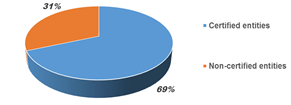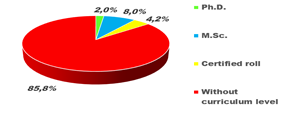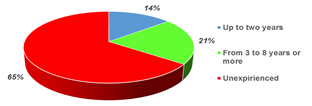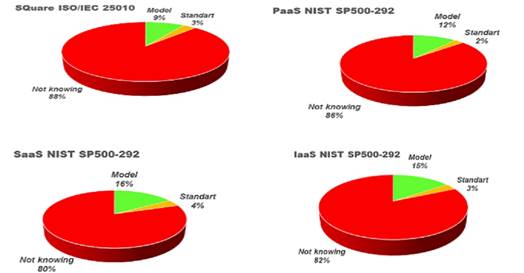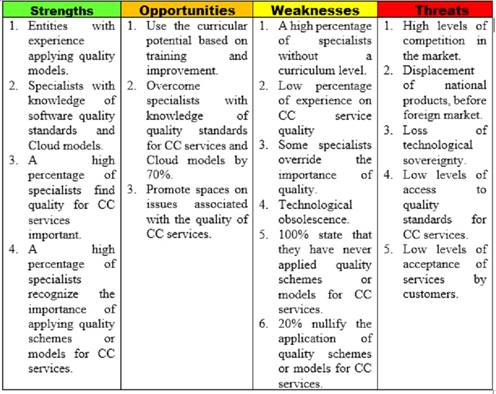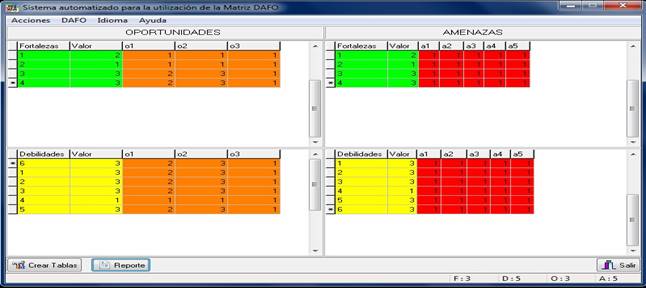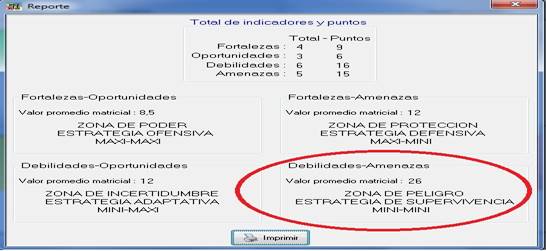Introduction
Nowadays it is impossible to conceive of a form of digitization that does not have a large part of its foundation based on cloudi infrastructures. The benefits and capabilities that it brings to companies, of any sector and size, when it’s combined with other technologies, is already the engine of economic and productive change that the market, current affairs and society are demanding of us, in order to face the consequences of health crisis we are experiencing. In light of what has been experienced in the COVID-19 health crisis, and the importance that technology has gained as a lever of activity for companies during the pandemic, it is clear that CC is crucial in digitization for the survival of any company and the economy of any country (Martil, 2020).
The development of cloud computing enhances the capacity of the ICT infrastructure through computing services (software, platforms or infrastructure) from a traditional mean (personal computer or cell phone, among others) to the Internet. In this way, the processing and storage of data and information can be carried out on remote servers through the internet and can be accessed from any online device. This procedure helps reduce technological infrastructure expenses as it offers various services to multiple companies and the government itself, thus facilitating their access to technology (Schatan, 2021).
The National Institute of Standards and Technology (NIST) defines cloud computing as a model for enabling ubiquitous, convenient, on-demand network access to a shared pool of configurable computing resources (for example, networks, servers, storage, applications, and services) that can be rapidly provisioned and released with minimal management effort or service provider interaction (Cedillo, Insfran y Abrahão, 2017).
According to ISO/IEC 17788, cloud computing is defined as the paradigm to enable network access to a scalable and elastic set of physical or virtual resources that may be shared with self-service provisioning and management on demand (ISO/IEC JTC1 SC38, 2014)(Merizalde, 2016; Cedillo, Insfran y Abrahão, 2017).
The definition of CC that (Kushida, Murray y Zysman, 2015) establishes in the article Cloud Computing: From Scarcity to Abundance, states and I quote: “Cloud computing delivers computing services-data storage, computation and networking - to users at the time, to the location, and in the quantity they wish to consume, with costs based only on the resources used”.
The CC suggests a model that allows the user to access standardized services to respond to their needs in an adaptive, fast and flexible way, paying only for the consumption made. This concept can be approached from three points of view: first, it is observed that cloud computing is the result of the evolution of a set of technologies that have been consolidated for several years; second, it is a technology trend that is enjoying great popularity and is being widely adopted; thirdly, the cloud computing-oriented development area continues to use the same methodologies of traditional development processes. The consolidation of cloud computing in the world has resulted in the appearance of concepts and definitions that allow classifying each service that can be offered through this mean; the way to identify these services is by using the suffix as a service - aas, this is how terms such as SaaS (Software as a Service) (Hou et al., 2010), PaaS (Platform as a Service) (Ardagna et al., 2012), IaaS (Infrastructure as a Service) (Guo, 2003), among others (Guerrero y Londoño, 2016).
In the report published by Eurostat, taking, from 2014 to 2018 as a reference, 27% of European companies applied cloud computing, mostly for email services and digital information storage. Of those companies, 55% used advanced cloud services related to financial and accounting software applications, customer relationship management, or the use of computing power to run business applications. In 2018, many more companies used public cloud servers (18%) than private cloud servers (11%), that is, infrastructure for their exclusive use, which demonstrates the recognition of many of the advantages that this new technology brings (KAMINSKA y SMIHILY, 2019).
On the other hand, a webinar offered by Ricardo Villate, GVP for Latin America at IDC states that in the last 3 years, half of IT spending has gone to the cloud, which reached 60% of all IT infrastructure and of all expenses in software, services and technology in 2020. Regarding Latin America, IDC forecasts for the current year 2022, more than 50% of GDP digitized, with growth driven by digitally enhanced offers, operations and relationships and almost 380 billion dollars, in IT-related expenses since 2019, in addition 70% of all IT spending in Latin America will go to third platform technologies within which CC is included, since more than 20% of cloud deployments by organizations in the region will include Edge Computing and 15% of devices will run Artificial Intelligence algorithms, showing that more than 75% of companies create digital-native IT environments in order to prosper in the digital economy”. As for development teams, IDC predicted that by 2020, 60% of all new Apps in Latin America will have microservice architectures that will improve the ability to design, debug, update, and take advantage of third-party code; while 25% of all production applications will be cloud native and added as another prediction that a new class of professional developers who produce code without custom scripts will expand the developer population by 15%, accelerating Digital Transformation. Finally, the adoption and use of the cloud and its delivery of computing services through the Internet - such as servers, storage, databases, networks, applications and capabilities such as data analytics, blockchain or artificial intelligence - have seen their adoption increase. and use this year due to the covid-19 pandemic (Barbieri, 2019).
Even though the above statistics mark a high trend in the use of CC as one of the emerging technologies of the 21st century (Cedeño Villacís, 2019), the strong roots of this technology with software quality should not be ignored, which is why it will increasingly important to evaluate the attributes that establish the norms and standards for any software product (Rozo, Casanovas y Pollo Cattaneo, 2020; Calloni et al., 2021).
According to the IEEE, software quality is "the degree to which the software possesses a combination of desired attributes" (IEEE Std. 1998). However, the intrinsic complexity of these products makes it difficult to determine the associated quality (Pressman 2010). In accordance with the above (Reina y Patiño 2019, p. 109) defines quality as the set of measurable subjective characteristics, which depend on the perspective of the requirements of the users of the product. This panorama worsens when trying to apply the existing concepts and techniques, on newer platforms based on modern execution models; such as, for example, the cloud computing scheme (Blas, Gonnet y Leone, 2016).
In recent decades, software quality models (SQMs) have become powerful support mechanisms for quality management (Deissenboeck et al., 2009). These models present a taxonomy of quality attributes together with a set of relationships that link them, which can be used as a reference framework during the elaboration of the initial specification, the evaluation of the design and the testing of a software system (Albin, 2003). On the other hand (Boukouchi, 2013) considers that there are two types of models: general and specific, developed with the aim of being used in any type of software, so the choice of quality attributes would be indistinctly applicable to any type of product. Instead of it, the specific models are designed to be used on a particular software class, where their attributes are chosen to cover quality characteristics of their class. Basically, and coinciding with what was previously expressed by (IEEE Std. 1998), applying an MCS to a specific software product is a real challenge.
Specifically for the topic addressed in this paper, some initial research such as "Cloud Based Development Issues: A Methodical Analysis" (Gill y Chana, 2012), began the study of CC tracing the roadmap towards 5 aspects that in a certain way established a beginning of quality in CC, which were based on: architecture, component-based development and reuse, design, security and quality of service, in this regard (Guerrero y Londoño, 2016) pre-select 206 articles from high impact on the subject, initially identifying 8 areas: infrastructure as a service, quality, security, conceptualization, software as a service, applied case, service level agreements and mobiles. For a second stage, it proposes 5 new subcategories for CC: quality of service, quality of the development process, quality of mobile computing in the cloud, quality of data and quality of experience, based on 50 studies and taking into account aspects not considered by the work of Singh and Chana (2012).
In recent years, some quality models have been proposed for CC services, such (Zheng et al., 2014), (Lee et al., 2009), (Wen y Dong, 2013), and (Zhou et al., 2015). In the particular case of (Zhou et al., 2015) presents a quality model called CLOUDQUAL, which specifies six quality dimensions: usability, availability, reliability, responsiveness, and elasticity. This model has only five metrics for CC in general, which prevents it from being applied to more specific CC environments (Merizalde, 2016).
The quality model proposed by (Lee et al., 2009) allows the evaluation of (SaaS), consists of five quality attributes: reusability, efficiency, reliability, scalability and availability, proposes a total of five metrics to measure the proposed attributes. Some notable disadvantages are its focus on evaluating the type of SaaS service, the internal/external product quality, and not the quality in use. And finally, it is based on ISO/IEC 9126, which, although it is a recognized standard , is outdated, since it has been replaced by the SQuaRE standard (Merizalde, 2016).
Another very similar model is the proposal of (Wen y Dong, 2013) designed for the evaluation of SaaS, built from the perspective of the platform, the supplier and the client, it allows to measure the security, the quality of the service, and the quality of the software, identifies key characteristics of SaaS services, its software quality metrics are the same as those of the ISO/IEC 25010:2011 standard and are also based on the Forrester model. This model is made up of levels: basic SaaS, standard SaaS, optimized SaaS and integrated SaaS, and for each level it has a set of metrics that are only significant for the provider and the consumer and, in contrast to the previous model, does not distinguish between metrics for the evaluation of the internal/external quality, nor the quality in use (Merizalde, 2016).
Another proposal (Zhou et al., 2015) presents a quality model for CC services, based on six characteristics: usability, security, reliability, tangibility, responsiveness, and empathy. Each characteristic has been divided into some sub-characteristics, proposing a set of metrics to evaluate these sub-characteristics, which are grouped into two categories: objective and subjective. In addition, they give a brief introduction to a methodology for the evaluation of quality for CC services, based on the ISO/IEC 25010 standard, categorizing product quality in characteristics, selecting those considered essential, without basing on what criteria of choice.
The usability, security and reliability characteristics are focused on the IT property of Cloud services, and those of tangibility, responsiveness and empathy focus on the service property of CC services. Although its model is based on the ISO/IEC 25010 standard, a clear distinction is not made between the internal/external quality of the product and the quality in use (Merizalde, 2016). Likewise (Merizalde, 2016), it summarizes that the previous models do not have a complete collection of quality attributes, with their respective metrics, that allow evaluating different categories of services (SaaS, PaaS, IaaS) and CC artifacts. (Cloud architecture, service in use) in different phases of the life cycle, and which in turn correspond to ISO/IEC 25010.
ISO/IEC 25000 comprises a set of rules that facilitate the development of a common framework responsible for measuring software product quality. It consists of five parts: quality management, quality model, quality measurement, quality requirements and quality assessment. In section 25010, the model for quality in use is specified, which establishes five characteristics that are: Effectiveness, Efficiency, Satisfaction, Freedom from risk and Context coverage (Jan y Werewka, 2015; Reina y Patiño, 2019).
In the particular case of our country, research has been carried out in this regard, such as (Suárez Batista, Febles Estrada y Trujillo Casañola, 2016) where the authors propose a change towards the business model that imposes the use of SaaS, as a strategic and challenging incentive for the entities that bet on it in Cuba. The authors, based on a diagnosis made to 85 IT service entities, identify some problems, such as the lack of knowledge of service quality models and the provision of services with a high component of improvisation, regardless of the fact that it is stated that none of the entities has experienced the application of CC service quality standards and models.
Cuba, based on notable advances in its digital transformation program (Estrada y Reyes, 2020; González Reyes y Febles Estrada, 2021; Milanés, 2018), dedicates great efforts to the development of software platforms with better features (Figueredo, 2021). Most of these applications are based on the public deployment of services and microservices through the Internet data network or server virtualization, among other aspects that are very familiar with Cloud Computing (Perdigón Llanes, Llanes y Alonso, 2020). Despite these advances, the issue of quality for the Cloud in Cuba remains a pending task, even in the new variant of certification for software in Cuba, proposed by (Oro, Alvarado y Ramírez Pérez, 2019).
The object of study of this research is oriented to the models and standards for the evaluation of quality in CC services, emphasizing the field of quality schemes to evaluate Software as a Service, based on the ISO/IEC 25010 standard. As a general objective: the diagnosis for the design of a quality scheme (QS) based on the attributes, expressed in characteristics and sub-characteristics, as well as the metrics defined in the ISO/IEC 25010 standard (Guerrero y Londoño, 2016; Silva et al., 2015; Blas, Gonnet y Leone, 2016), (Cedillo, Insfran y Abrahão, 2017).
Methods or Computational Methodology
As previously seen, for the framework of this work, a bibliographical study was carried out on the problems and evolution of the state of the quality of CC services, in the international sphere (Guerrero y Londoño, 2016), (Silva et al., 2015), (Zúñiga y Gabriel, 2017), (Merizalde, 2016), (Callejas-Cuervo et al., 2017), (Cedillo, Insfran y Abrahão, 2017) and national sphere.
The initial diagnosis of this research begins with the design and application of a survey in order to collect statistics that could reveal the level of knowledge regarding quality issues of CC services in Cuban entities. The data collected allows us to know how the importance of software quality in CC environments is valued, as well as the importance of applying them, in addition, an exercise is presented to evaluate the levels of uncertainty in terms of identifying software quality standards of CC services and Cloud implementation models, referenced in research, which have developed quality schemes or models that can be applied to that environment.
As a diagnostic technique, a SWOT analysis is applied, which allows the analysis or evaluation of problems in the internal organizational context, which help to determine the factors that impact the organization and favor the planning of strategies that allow forging competitiveness (González G, 2020; Luis y Rojas, 2022). Through its application, it will be possible to trace a route that allows software development entities and IT services in Cuba to face the CC environment, under the guidance of quality standards and models. As an outstanding result, the negative impact, caused by the absence of this knowledge, for the development of a product with quality in CC, is exposed. All of the above is the argument that justifies the general objective of this investigation.
Based on some problems reflected in the diagnosis, which (Suárez Batista, Febles Estrada y Trujillo Casañola, 2016) presented at the national level, the persistence of some aspects of this problem is demonstrated, which objectively respond to the objective of this investigation.
Within the framework of this research, software development entities and IT services in Cuba are identified as a population. The population sample is characterized by 16 national entities, with a total of 500 specialists, of which 404 belong to 11 entities, representing 80% of the sample, which at the same time have been under the CMMI - DEV certification at the managed level.
The indicators that are measured are classified as: engineering roles, curricular level, years of experience in CC quality models, the importance attributed to quality in CC, as well as the criteria of its application, in the development of Cloud products. The data is expressed as a representative percentage of the total.
Results and Discussion
During the previous gathering of information, as shown in figure 1, it has been considered that 69% of the entities that have been surveyed were certified at some point under relevant aspect quality models, which can be accepted in the SWOT analysis, as a strength.
As primary data, the sample is characterized by 10 specialists, who hold the scientific degree of doctor of technical sciences, associated with the development and quality of software, which represents 2% of the total. In the category of master in subjects associated with software development and quality, 40 respondents represent 8%. With at least one certification in computer engineering roles, 21 respondents, turned out to be 4.2% and as specialists without any curricular level 429, which represents 85.8%, as shown in figure 2. The representation of 14.2% of the respondents supported by a curricular level, means another strength, fundamentally based on the opportunity to instruct the rest of the specialists, through the promotion of training variants, talks, courses, on issues associated with quality in CC environments.
Regarding the years of experience with quality standards and CC models, 70 specialists were 2 years or less for 14%, between 3 and 8 years or more 105 specialists represents 21%, and without any kind of experience, 325 specialists resulted, for 65% which is the most representative level for this indicator, as shown in figure 3. The previous result positively represents that more than a third of the specialists surveyed identify with the paradigm of the Cloud, which could represent a movement towards that digital transformation, guided by knowledge and not improvisation.
In the data referring to the levels of importance, which is attributed to quality in CC, shown in figure 4, 262 respondents voted for very high, which represents 52.4%, in the high level 205 specialists, for 41%. For a medium level of importance, 18 respondents represented 3.6% and for the level of low and null importance, 15 respondents voted for a cumulative 3% of the sample. The interpretation of these data implies that around 93% find the quality of services in CC environments important.
Another important piece of information turned out to be the importance that respondents gives to the use of a quality model in CC, a measurement that yielded 202 votes at the very high level, representing 40.4%, and 204 at the high level, for 40.8. %, dividing these two levels by the highest percentage. At the level of medium importance, there were 71 votes, which represents 14.2% and only 23 votes nullify the importance of using a quality model in CC, for 4.6%. As a partial conclusion, it can be affirmed that 80% of the surveyed finds important to apply a model or a quality scheme for the services of the CC environment, as can be seen in figure 5.
Taking into account that the quality standards for CC services and models present in the survey have been selected from the bibliographic study, where more than 10 authors agree on their application for the evaluation of quality in CC services, in the figure 6 can be observed how the respondents responded. The 79.8% are totally unaware of the quality standards for CC services and models, approximately 6% identified them erroneously, which reflects conceptual problems and despite the fact that 8.6% identified them well, 100% of the respondents claim that they have never applied no model or quality schemes for CC services based on any standard. In this regard, one of the causes is the low accessibility to the standards, by the institutions or software production entities in Cuba, mostly associated with the intensified blockade imposed by the United States of America.
In contrast to what is stated by (Suárez Batista, Febles Estrada y Trujillo Casañola, 2016), the result of the information gathering carried out on the specialists in these 16 entities, allows us to reaffirm that the identified problems persist, although it is possible to emphasize that an analysis is not made, which supports decision-making, with strategic determination for that situation. This leads to a deeper analysis, not addressed by the authors of this research, which allows determining at what time these entities are, to face the Cloud environment.
The interpretation of the previous data made posible the identification of a group of 4 strengths, 6 weaknesses, 3 opportunities and 5 threats, as shown in table 1. This analysis consists of creating a scoring scale, where the highest value represents the highest impact, thus the medium value score will also be assigned for medium impact on the scale and the lowest, for least impact. The processing of each of the elements is carried out using a computer tool, where once the values are granted, each strengths and weaknesses variable is matched one by one, with each of the opportunities and threats, as shown in figure 7.
Through this analysis, a strategic route can be determined, which contributes to making decisions, based on the position suggested by the bidimensional array, as shown in figure 8. In this case, the application of the SWOT method has yielded a strategic position of survival, which indicates a high influence of negative factors, both internal and external, represented by weaknesses and threats.
Conclusions
As a predictive result of this diagnosis, it has been shown that the entities, which have been the object of the diagnosis, are not in a favorable position, for a jump to CC-based technologies, given the notable lack of knowledge regarding the conceptualization of its models and the standards that govern quality for CC services. On the other hand, the risk of improvisation persists, during the software development process, by ignoring the application of schemes or models, based on the ISO/IEC 25010 standard, a determining aspect to achieve quality in those services. Likewise, failing at accomplishing the foregoing would increase consumer dissatisfaction, affecting principles such as security and technological sovereignty, when consumers prefer services provided by foreign markets. Due to the aforementioned and given the result of this survey, it is very important that decision-making focuses on the survival strategy, managing to minimize the weaknesses identified, as a priority, based on the use of the opportunities provided for the strengths. Finally, there is the opportunity to deepen the knowledge of the quality standards, for the future design of schemes (QS) and CC service quality models from the attributes, expressed in characteristics, sub-characteristics and metrics defined in the ISO/IEC 25010 standard.













